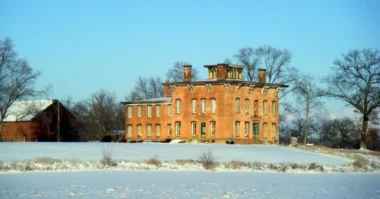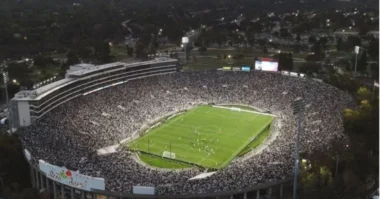Table of Contents
The world of golf is buzzing with excitement as one of the biggest tournaments in the sport is set to return to one of its most historic and challenging venues. In 2025, the U.S. Open Golf Championship will be held at Oakmont Country Club, a course known for testing even the best players in the world. This news has thrilled golf fans everywhere, as Oakmont is often described as one of the toughest and most iconic golf courses in the United States.
What is the U.S. Open Golf Championship?
The U.S. Open is one of the four major golf championships in the world, often called a “major.” Organized by the United States Golf Association (USGA), the tournament attracts the best golfers from around the globe.
The U.S. Open is known for:
- Tough course conditions
- High-pressure situations
- Intense competition
- Large crowds and big media coverage
The tournament is open to both professional and amateur players who qualify through a series of regional competitions. Winners of the U.S. Open earn not just a trophy and prize money but also respect in the golf world. It is one of the hardest championships to win, and every player dreams of holding that title.
Why is Oakmont Special?
 Oakmont Country Club, located near Pittsburgh, Pennsylvania, is often called one of the most difficult golf courses in America. Founded in 1903, the course has hosted more major championships than any other U.S. course.
Oakmont Country Club, located near Pittsburgh, Pennsylvania, is often called one of the most difficult golf courses in America. Founded in 1903, the course has hosted more major championships than any other U.S. course.
Here’s why Oakmont stands out:
- Fast and sloped greens that test putting skills
- Deep bunkers are placed in challenging positions
- Long, rough grass that punishes missed shots
- Classic design with very few trees but lots of strategic hazards
Oakmont is famous for being tough but fair. It pushes players to be precise and strategic. Many past champions have called it the hardest course they’ve ever played. When the U.S. Open is held at Oakmont, it becomes a true test of a golfer’s skill, patience, and mental strength.
History of the U.S. Open at Oakmont
The 2025 championship will not be Oakmont’s first time hosting the U.S. Open. It will be the 10th time the tournament has come to this legendary course.
Here’s a quick look at some memorable past moments:
- 1927: Tommy Armour won in a dramatic playoff
- 1962: Jack Nicklaus beat Arnold Palmer in his first major win
- 1994: Ernie Els claimed victory in a tight contest
- 2007: Ángel Cabrera shocked the field with a gutsy performance
- 2016: Dustin Johnson overcame a rules controversy to win his first major
Each U.S. Open at Oakmont has brought its own stories, surprises, and stars. The course never disappoints when it comes to delivering drama.
A Tournament of Drama & Skill
The 2025 U.S. Open Golf Championship at Oakmont Country Club in Pennsylvania was nothing short of a rollercoaster. Known for its brutal rough, glassy greens, and historic difficulty, Oakmont once again proved why it’s considered one of the toughest tests in golf. From the opening round to the final putt, fans were treated to a thrilling mix of talent, pressure, and pure heart.
1. Opening Rounds
The first round set the tone for the tournament. Right from the beginning, players struggled against Oakmont’s punishing layout. But one player stood out—J.J. Spaun, who carded an impressive 66. On a course where bogeys are common and birdies are rare, Spaun’s round was nothing short of brilliant. The lightning-fast greens and thick rough humbled even the world’s best players. After two rounds, only a few managed to stay under par, including Sam Burns, Viktor Hovland, and Spaun himself.
2. Mid-Tournament Showdowns
As the weekend approached, Sam Burns climbed to the top of the leaderboard, finishing Round 3 at four-under-par. Right on his heels were Spaun and Adam Scott, who made a strong charge with steady play and clutch putting. The third round was filled with tense moments, where even the smallest mistake could ruin a player’s chances. Meanwhile, names like Thriston Lawrence, Carlos Ortiz, and Viktor Hovland stayed in the hunt, creating an exciting and unpredictable leaderboard heading into Sunday.
3. Final Round & Triumph
On Father’s Day, June 15, J.J. Spaun gave golf fans a moment they’ll never forget. Battling nerves, fierce competitors, and Oakmont’s relentless layout, Spaun delivered a final-round performance full of resilience. After early struggles and a couple of bogeys, he kept his cool and made a remarkable comeback.
Then came the moment of magic: on the 18th green, Spaun faced a long, breaking 64-foot birdie putt. With the crowd holding its breath, he rolled it in perfectly. That jaw-dropping putt not only sealed his victory but added another unforgettable chapter to Oakmont’s legendary history.
The Course Layout and Key Holes
 Oakmont Country Club is one of the most iconic and challenging golf courses in the world. With 18 holes designed to test every part of a golfer’s game, Oakmont demands accuracy, patience, and nerves of steel. Each hole has its character, but a few stand out as game-changers.
Oakmont Country Club is one of the most iconic and challenging golf courses in the world. With 18 holes designed to test every part of a golfer’s game, Oakmont demands accuracy, patience, and nerves of steel. Each hole has its character, but a few stand out as game-changers.
1. Hole 1 – The Start
Don’t be fooled by its short distance. The first hole looks simple, but its tight fairway and deep bunkers make it a dangerous opening. A poor start here can shake even the most confident player.
2. Hole 3 – The Church Pews
This par-4 hole is home to Oakmont’s most famous feature: the Church Pew bunkers. These wide, deep sand traps lined with grassy ridges punish anyone who strays from the fairway.
3. Hole 8 – The Monster
Known as one of the toughest par-3s in championship golf, Hole 8 often plays over 250 yards. Simply reaching the green is considered a small victory.
4. Hole 18 – The Finisher
The final hole at Oakmont is both beautiful and brutal. With a narrow fairway and a sloping green, it often decides the champion. Many tournaments have ended in heartbreak or triumph right here.
How the U.S. Open Prepares Oakmont?
Before the championship begins, Oakmont goes through months of preparation. The USGA works closely with the course to make sure everything is perfect.
Here’s what they focus on:
- Speeding up the greens to test putting precision
- Growing out the rough to punish inaccurate shots
- Setting up tee boxes to create variety
- Placing pins in hard but fair locations
This process is about creating a balance between challenge and fairness. The goal is not to embarrass players, but to make them earn every shot.
What Players Are Saying?
Many top golfers have already spoken about how excited they are to return to Oakmont. Quotes from past champions highlight just how special the course is.
- Dustin Johnson: “Oakmont is the ultimate test. If you win here, you’ve earned it.”
- Rory McIlroy: “There’s nowhere like it. Every hole demands full focus.”
- Jordan Spieth: “You remember every shot you take here, good or bad.”
Such praise shows why Oakmont is respected and feared in equal measure.
Key Takeaways
- Historic venue: Oakmont’s 10th U.S. Open, with a rich legacy of major champions.
- Toughest test: Narrow fairways, fast greens, deep rough, and iconic bunkers.
- Elite field: Over 10,000 entrants, 156 players, featuring world‑class golfers and determined amateurs.
- Drama & triumph: J.J. Spaun’s clutch performance sealed his first major with a record‑length putt.
- Fan impact: Massive attendance, local infrastructure upgrades, and global broadcasting reach.
- Golf future: Oakmont’s continued role as a centerpiece of USGA rotations through at least 2049.
Final Thoughts
The 2025 U.S. Open at Oakmont wasn’t just another golf tournament; it was a battle of precision, nerve, and tradition. With its unforgiving setup and storied history, Oakmont truly lived up to its title as the University of Hard Knocks for golf professionals. From record participation in qualifying to moments of greatness and heartbreak, this Open reaffirmed what we already knew: Oakmont is golf at its most uncompromising and exhilarating.








